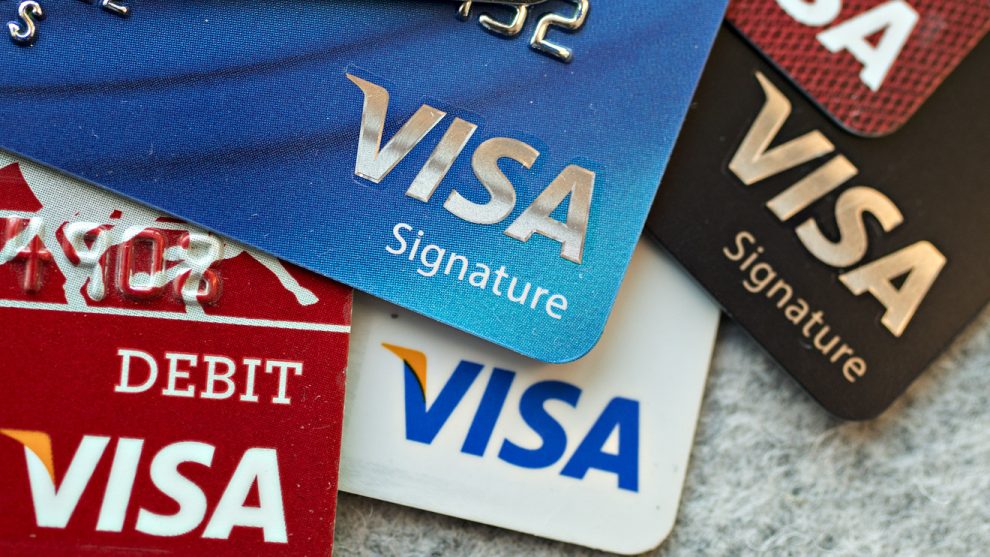
Visa Inc. saw a “significant deterioration” in spending toward the end of March amid the COVID-19 crisis, but some areas of the business seem to be improving.
The company topped profit and revenue expectations Thursday afternoon, earning an adjusted $1.39 a share for the fiscal second quarter on revenue of $5.85 billion. Analysts surveyed by FactSet were modeling $5.72 billion.
Shares V, -1.68% were down 0.7% in after-hours trading.
Visa also shared data points from beyond the March quarter, indicating that U.S. payment volumes in the U.S. were down 19% through April 28, with debit down 6% and credit down 31%. E-commerce volume was up 18% in April, while card-present volume was off 45%.
The company is seeing “significant differences in how lockdowns have been impacting spend categories” in the U.S., with volume trends at places like drugstores, Walmart Inc. WMT, -1.65% , and Target Corp. TGT, -2.10% stores up about 20% in April.
“Essentially all growth is coming from online spending, up over 100% in the last two weeks of April, assisted by the adoption of curbside pickup and delivery,” Chief Financial Officer Vasant Prabhu said on Visa’s earnings call.
Spending on areas like telecommunications, utilities, insurance and business supplies is “holding up relatively well,” with a 15% drop at the end of March and a recovery to “flat” April growth relative to the year-earlier period.
Those two spending categories each account for about a fifth of Visa’s U.S. volumes, though the company has greater exposure to areas that have been more thoroughly impacted by the COVID-19 outbreak.
A third of Visa’s U.S. volume comes from areas like retail, automotive, health care and education, categories where spending is declining between 15% to 50%, Prabhu said. And about a quarter of domestic volume comes from even harder-hit areas like fuel, travel, restaurants and entertainment, all of which are down at least 50% in March, with travel spending in particular down about 80%.
Prabhu disclosed that debit volumes actually “spiked into positive territory” in the U.S. during the last two weeks of April “as the first wave of economic-impact payments were distributed,” though the company isn’t yet sure if that marks the beginning of a recovery, a plateau, or a trend that may reverse in a few weeks.
“Notably, the company was transparent about being unsure whether this end-of-April improvement — which was likely boosted by government stimulus — will prove sustainable or not,” Barclays analyst Ramsey El-Assal wrote following the earnings call.
Internationally, markets such as Canada and Europe have seen similar trends to the U.S., he said, while Australia has seen “a shallower decline.” Cross-border volumes declined 2% in the first quarter and were down 43% through April 28, or 52% excluding transactions within the European Union.
The card giant is trying to grow adoption of tap payments coming out of the crisis due to heightened concerns about possible germ spread through cash exchanges. It has set up a site where merchants can request signage for their stores indicating that contactless payments will be accepted there and it has been working to increase the transaction limits for tap payments.
The company said in a blog post that 31 million people in the U.S. paid with a Visa contactless card or digital wallet in March, up from 25 million in November. Overall usage of contactless payments is up 150% since last March, according to the post.
Don’t miss: Apple earnings dip amid coronavirus pandemic, but investors set to receive billions more
Visa’s report comes a day after rival Mastercard Inc. MA, -3.07% posted its earnings. Mastercard also showed a slowdown in spending trends as the coronavirus outbreak worsened, though Mastercard’s management sounded upbeat as well about a more recent stabilization. While Mastercard expects travel-related spending to remain stubborn, the company also saw e-commerce make up a greater portion of overall volume as more people gravitate to online services during the pandemic.
Both Visa and Mastercard are making a push to grow the usage of tap payments in the U.S. and around the world as the card companies view contactless transactions as a way to entice consumers to use digital payment methods more often.
“We’re comforted by the fact that Visa is taking solid action around expenses in the back half of F2020 and the reiteration of the buyback program for the remainder of the year, both of which we believe will help to offset some of the headwinds to top-line growth,” Keefe, Bruyette, & Woods analyst Sanjay Sakhrani wrote in a note to clients after the report.
Wedbush’s Moshe Katri expects “strong ancillary services as well as cross border ecommerce to also provide offsets to a weak cross-border vertical.” Visa is seeing interest in services that make use of data and those that help store card credentials.
Visa shares have lost 14% over the past three months as the Dow Jones Industrial Average DJIA, -1.17% has declined 16%.











Add Comment